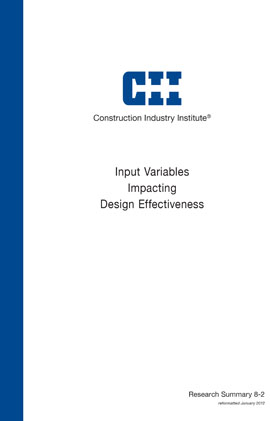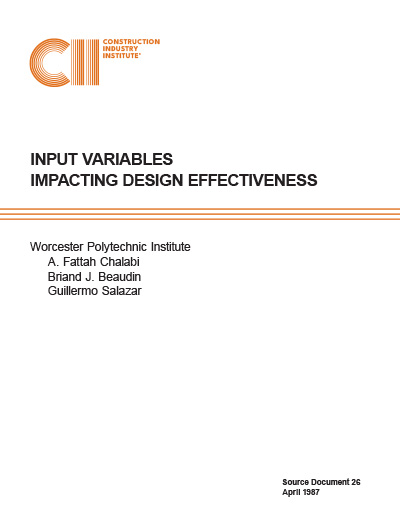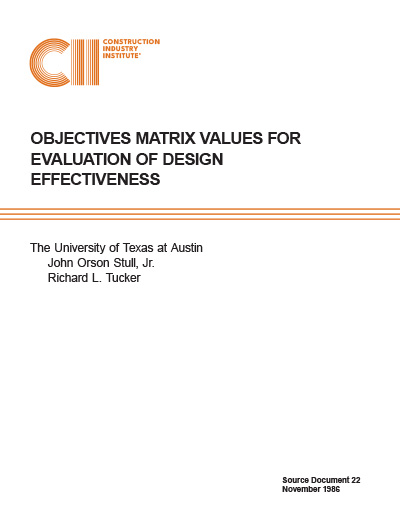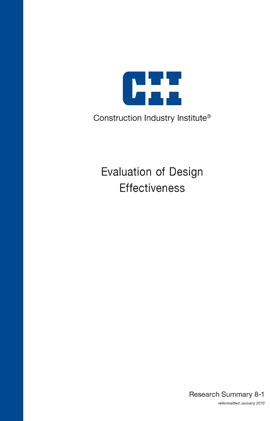
Input Variables Impacting Design Effectiveness
Design is a complex process involving the reconciliation of competing objectives and constraints, and is a major determinant of project success. Decisions that are made at early phases, including project initiation studies, the design contract, and basic engineering, have the highest influence on the project. These decisions and other constraints form input variables to design. Over 40 input variables were identified during the research effort that is the basis of this publication. The 10 input variables identified as having the greatest impact on design effectiveness are:
- Scope Definition
- Owner Profile and Participation
- Project Objectives and Priorities
- Pre-Project Planning
- Basic Design Data
- Designer Qualification and Selection
- Project Manager Qualifications
- Construction Input
- Type of Contract
- Equipment Sources
Design effectiveness is measured by design outcome parameters. The research identified 25 outcome parameters. The following seven were correlated with the 10 inputs, and then were used to weight their impact on design effectiveness.
- Final Project Schedule
- Constructability
- Quality of Design
- Final Project Cost
- Plant Start-Up
- Performance
- Safety
The research methodology included analysis of design procedures, and extensive data from four projects and summary data from 16 projects. The research objectives included: (1) subjective correlation of the input variables with the design outcome parameters, and (2) the development of recommendations to modify the negative impacts of the input variables. To attain these objectives, heavy participation by the industry was sought throughout the research. Additionally, owners, designers, and constructors from 21 companies participated in an experts’ workshop to exchange views, rank the input variables, assess their impacts on various design outcome parameters, and make recommendations to influence in a positive manner the inputs. Recommendations for influencing each input variable are presented separately. When taken together, these recommendations can be used as a guide on design effectiveness.
Several conclusions are made, among which are the following:
- The owner, by far, is the major contributor of design input variables.
- If early input variables are handled properly, other variables later in the project are positively impacted. Therefore, input variables must be properly managed as early as possible.
- Companies can identify input variables to their type of projects and organizations, and develop steps to moderate the negative impact of these variables.
- Owners should carefully identify project objectives and priorities so design outcome parameters will not compete and thereby reduce design effectiveness.
Over 40 input variables that may impact design effectiveness were identified during the research, while the 10 input variables, listed below, were identified as having the greatest impact on design effectiveness. The magnitudes of the impact of each of these input variables are identified in the research along with recommendations for each of these 10 input variables. Overall failure to manage design input could increase total project cost by 25 percent or more. (RS8-2, p. 11)
- Scope Definition
- Owner Profile and Participation
- Project Objectives and Priorities
- Pre-Project Planning
- Basic Design Data
- Designer Qualification and Selection
- Project Manager Qualifications
- Construction Input
- Type of Contract
- Equipment Sources
Further design effectiveness is measured by design outcome parameters and the research identified 25 outcome parameters. These seven outcome parameters were selected as the key outcomes to measure the effects of the above 10 input variables on design effectiveness.
- Final Project Schedule
- Constructability
- Quality of Design
- Final Project Cost
- Plant Start-Up
- Performance
- Safety
Source Documents, SD-19 and SD-26, provide supporting research details for Key Finding # 2.



